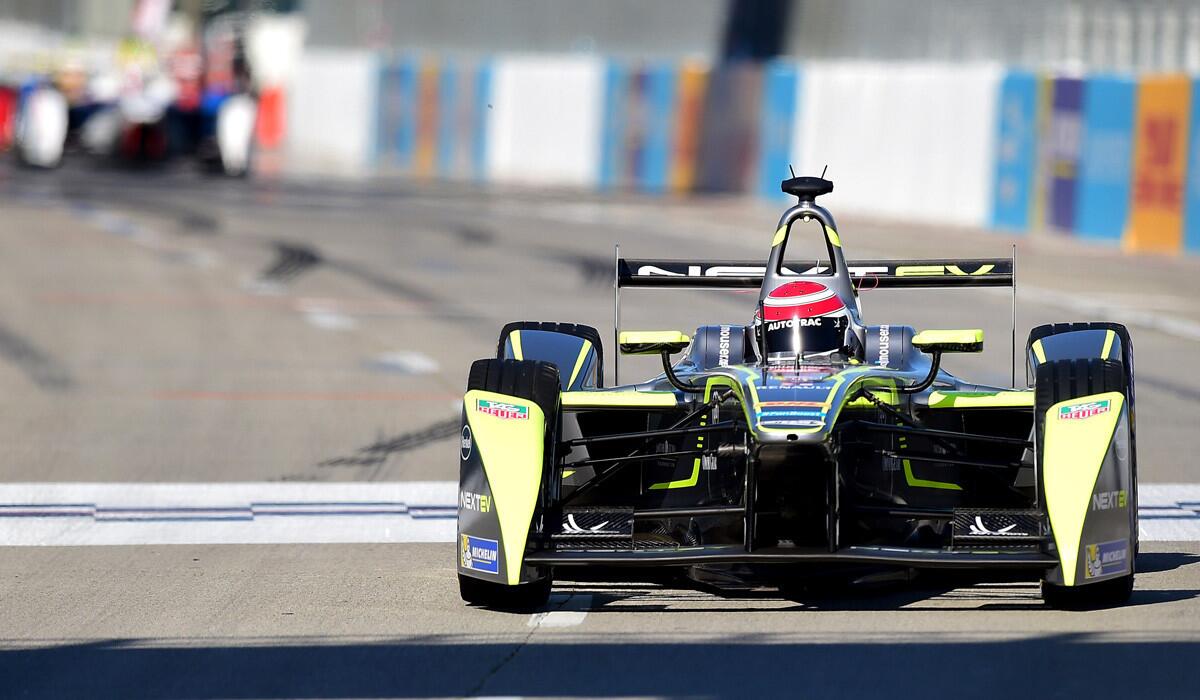Nelson Piquet Jr. wins first Formula E race in Long Beach

- Share via
Many of the spectators in Long Beach had the same reaction Saturday when they watched the cars race by for the first time.
The fans broke into a smile, turned to their companions and said, in so many words: “Isn’t that interesting?”
Indeed, many never had seen anything like it: Electric-powered race cars that whisked by with the sound of a high-pitched vacuum cleaner instead of the conventional roar of an internal-combustion engine.
The novelty was Formula E, a new series whose 10-race global schedule included Saturday’s inaugural race on the same seaside streets used in the long-running Toyota Grand Prix of Long Beach.
The Long Beach ePrix, as it was called, was the sixth race of the season and Brazilian Nelson Piquet Jr. handily won the one-hour event on the seven-turn course. Jean-Eric Vergne finished second.
“It’s hard to believe, everything worked out,” said Piquet, who’s father won at Long Beach in 1980 when it was a Formula One race. “It means a lot.”
The younger Piquet also was the sixth winner in the first six races of the Formula E season.
Each of the race’s 20 drivers had to change to a second car during a pit stop because one car’s battery life isn’t yet strong enough for the full hour, which covered 39 laps.
Formula E, which is sanctioned by the FIA, the governing body of the Formula One series, also races in Europe, Asia and South America. Its only other U.S. race, on the streets of Miami, was three weeks ago.
General admission to the Long Beach race was free and, while that meant ticket sales weren’t available, the race drew several thousand people.
One sensation of the Formula E event was just how quiet it all was compared with the conventional Long Beach Grand Prix. As the cars maneuvered through corners, for instance, the squeal of sliding tires were clearly heard instead of being drowned out by engine noise.
But Formula E is meant to be different, a showcase for demonstrating so-called sustainable technology and how racing can push the boundaries of clean-energy vehicles.
Seeing Formula E cars is similar to when people first saw “the fax [machine] or the mobile phone,” said Pier Luigi Ferrari, deputy managing director for motorsports at DHL, which ships Formula E’s cars from race to race.
The series’ goal is to be part of “the new reality where electricity is looking like the future” in vehicles, especially in California where hybrid-powered cars are among the market’s bestsellers, he said.
The conventional race cars of the Verizon IndyCar Series will be back for the 41st annual Long Beach Grand Prix on April 19.
More to Read
Go beyond the scoreboard
Get the latest on L.A.'s teams in the daily Sports Report newsletter.
You may occasionally receive promotional content from the Los Angeles Times.










